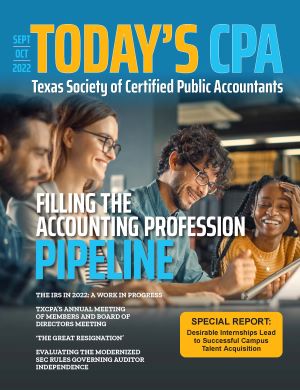The Great Resignation Survival Guide
Five Best Practices for Accounting Firms Facing Severe and Unique Challenges
By Lee Frederiksen, Ph.D.
Pundits call it the “Great Resignation” and professional services firms are among the hardest hit. The response to the pandemic and resulting shutdowns brought into clear focus ideas on work-life balance, remote work and the benefit of a shared cultural fit. Not all organizations have recognized this swing, but they are feeling the effects of it.
Accounting firms are acutely at risk during this time. Hinge’s Employee Branding Study, conducted after the pandemic’s onset, offers insights that will help your firm during this time of shifting landscapes and priorities.
To attract and retain top talent, accounting firms must rethink their employee engagement strategy. Now more than ever, a highly visible and robust employer brand will help you attract top talent.
Risks to CPA Firms During “The Great Resignation”
A growing shortage of CPAs has been brewing for more than a decade. Many Baby Boomers are leaving the workforce now that they have reached retirement age. At the same time, fewer young people are interested in becoming CPAs, leaving many firms with a small pool of qualified candidates. It’s a perfect storm for accounting and tax firms.
Many young adults have grown up hearing stories of financial scandals and abuses, which doesn’t fit their search for meaningful work and purpose. These young adults also fear senior leadership will overlook their accomplishments or potential because of their age.
This is a daunting challenge for accounting firms. Still, predictive patterns can help us recognize when the risk is most significant for losing star employees – and point to possible solutions.
Risk Factor One: Mergers and Acquisitions
Almost 40% of surveyed accounting and tax firms in the United States had a merger or acquisition in the last three years, the highest rate among professional service firms.i Mergers and acquisitions have become a popular way for CPA firms to find the talent and services they need to grow their bottom line. Yet, how a firm handles a merger can directly impact employee satisfaction and retention.
Of those surveyed, 24% in the accounting profession had a negative experience with a merger or acquisition. In our study, 69% of respondents cited a lack of a formal integration plan as the strongest driver of employee dissatisfaction. These individuals also called out a need for someone to oversee the merger (38%) and for clear communication with employees throughout the merger process (38%).
Employees whose firms have been acquired are at an increased risk of leaving. More than 40% of passive seekers – those who are not actively seeking jobs but are open to new opportunities – are more likely to seek employment at a new organization after an acquisition.
Risk Factor Two: Pandemic Response
At the onset of the pandemic, organizations worldwide had to come to grips with a new workplace “normal.” Our study uncovered that virtually all active job seekers were dissatisfied with how their firms handled COVID-19, while most non-job seekers (66%) were happy with their firm’s plans and communication.
For accounting firms, less than half of all respondents were highly satisfied with their employer’s response to COVID-19. Forward-looking organizations actively planned for life after the pandemic, with contingency plans and open dialogue to understand their employees’ fears and priorities.
What Drives Job Seekers
Hinge Research Institute’s Employer Branding Study: Second Edition was conducted during unusual times, but the principles for thriving during The Great Resignation are universal.
Now is the time to rethink your retention and recruiting strategy. Start by considering the factors that tip the scale for employees. While competitive salaries are the leading factor for employees looking for a job, there are other factors your firm should also consider.
In the Employer Branding Study, factors apart from pay that tipped the scale for job seekers were:
- A clear vision for the future and strong leadership,
- The team they will work with directly, and
- Good cultural fit and shared values.
Now that you have an idea of what candidates are looking for, it’s essential to ensure your organization is visible to top accounting talent.
Five Best Practices for Building a Highly Visible, Robust Employer Brand
Your employer brand is your reputation as a workplace or employer, and it is essential to your recruitment and retention efforts. A successful brand sets your firm apart from competitors. It clearly articulates the vision and culture of your organization, which helps attract qualified candidates at all levels. There are five things to consider when putting together an employer branding strategy.
1. Take your business model into account.
Different models require different workforce profiles. Aligning the employer brand with business strategy will help you obtain management support for the branding effort.
2. Make your strategy visible and easy to understand.
A brand with key features that are hard to identify, let alone articulate, presents challenges to internal and external audiences. To your team, a complex brand is difficult to implement and raises the risk that people will carry out the wrong brand – a frequent issue with professional services firms.
To the outside world, a brand that lacks online visibility doesn’t exist. Add to that complexity and the brand has little chance to draw the buyers and talent a business needs to grow. Your organization’s story should be told across your website, social media channels and created content, giving future employees a glimpse into your organization. Pay close attention to search engine optimization (SEO) to make sure the talent you’re looking for can find you and adjust when necessary.
3. Align your employer brand strategy with your corporate brand.
If your brand stands for expertise in performance audits for government markets, your employer brand should emphasize continual talent development in areas of expertise that meet the financial and compliance improvement challenges of government agencies. Your employer brand will help you fulfill the promise of your corporate brand.
4. Take a research-driven approach.
Branding should be based on research into your current and prospective talent, as well as referral sources. This approach will show you where the gap between your current and desired reputation lies and how to close it.
5. Monitor results so you can adjust your plan and implementation as needed.
Branding and rebranding are huge investments. You need to ask yourself two questions. Did we follow the plan? Did we achieve the results we expected from it?
Building a Strong Culture and Brand
What will potential employees find out about your organization when they conduct a Google search? It’s essential to know the answer.
A well-coordinated and creative plan will put your organization in front of potential employees. It will set you apart from your competitors and engage current employees who might be considering taking another job.
Potential employees will not be the only ones who notice. Building a strong culture and brand will resonate with prospects and clients as well.
About the Author: Lee W. Frederiksen, Ph.D., is managing partner at Hinge, the leading research-based branding and marketing firm for professional services. Contact her at lfrederiksen@hingemarketing.com. Hinge conducts ground-breaking research into high-growth firms and offers a complete suite of services for firms that want to become more visible and grow.
Source
i Hinge Research Institute. (2020). The Employer Branding Study. Reston, VA: Hinge Strategies.

















